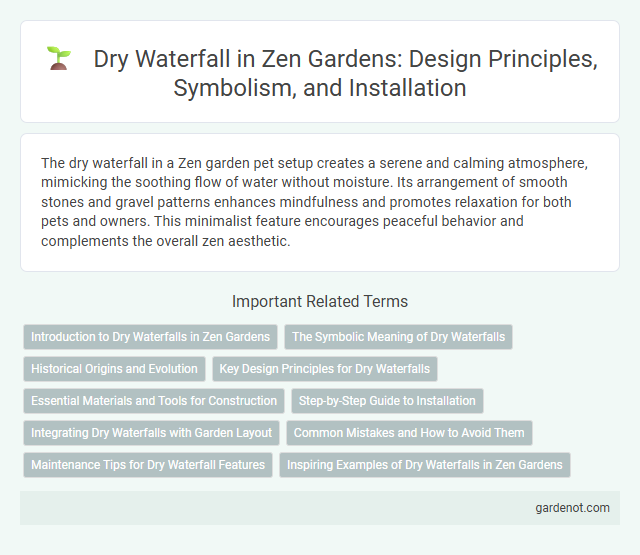The dry waterfall in a Zen garden pet setup creates a serene and calming atmosphere, mimicking the soothing flow of water without moisture. Its arrangement of smooth stones and gravel patterns enhances mindfulness and promotes relaxation for both pets and owners. This minimalist feature encourages peaceful behavior and complements the overall zen aesthetic.
Introduction to Dry Waterfalls in Zen Gardens
Dry waterfalls in Zen gardens symbolize the fluid movement of water using carefully arranged rocks or gravel to mimic cascading flows. These elements create a sense of tranquility and rhythm without the presence of actual water, enhancing meditative atmosphere. Strategically placed stones and raked gravel patterns evoke natural waterfalls, embodying Zen principles of simplicity and harmony.
The Symbolic Meaning of Dry Waterfalls
Dry waterfalls in Zen gardens symbolize the continuous flow and impermanence of life despite the absence of water, representing tranquility and the mind's clarity. These minimalist stone arrangements evoke the sound and movement of cascading water, encouraging meditation on nature's cycles and inner reflection. Their design emphasizes simplicity, balance, and harmony, reflecting Zen principles and spiritual mindfulness.
Historical Origins and Evolution
Dry waterfalls, known as karesansui in Japanese Zen gardens, originated during the Muromachi period (1336-1573) as symbolic representations of water using carefully arranged rocks and gravel. These features evolved from ancient Chinese landscape painting techniques and Buddhist philosophies emphasizing simplicity and meditation. Over centuries, dry waterfalls have maintained their spiritual significance, embodying the flow and stillness of water while enhancing the contemplative atmosphere of Zen gardens.
Key Design Principles for Dry Waterfalls
Key design principles for dry waterfalls in Zen gardens emphasize the use of carefully arranged rocks to mimic the natural flow of cascading water, creating a sense of movement and tranquility without liquid. The selection of stones varies in size and texture to suggest the dynamic energy of falling water while maintaining harmony and balance within the overall garden composition. Incorporating symbolic elements such as gravel ripples around the rocks enhances the visual illusion and reinforces the garden's contemplative atmosphere.
Essential Materials and Tools for Construction
Constructing a dry waterfall in a Zen garden requires essential materials such as smooth river rocks, gravel, and natural stones to mimic the appearance of cascading water. Tools like a spade, rake, wheelbarrow, and garden hose are necessary to shape the landscape and ensure proper alignment of the stones. Attention to texture, color variation, and stone placement enhances the tranquil, flowing illusion characteristic of traditional Japanese dry waterfalls.
Step-by-Step Guide to Installation
A dry waterfall in a Zen garden creates a serene focal point using carefully arranged stones to simulate cascading water without moisture. Start by selecting a suitable location with a natural slope, then excavate the area to lay a stable base of compacted gravel for drainage. Arrange flat, textured stones in descending layers, securing them with sand or soil to replicate flowing water's movement while maintaining simplicity and balance.
Integrating Dry Waterfalls with Garden Layout
Integrating dry waterfalls into Zen garden layouts emphasizes creating visual flow and natural rhythm through carefully arranged rocks and gravel patterns that simulate cascading water. Placement of larger stones at varying heights, surrounded by raked gravel, guides the viewer's eye while maintaining harmony with surrounding plantings and pathways. This strategic design enhances tranquility and encourages mindful contemplation, embodying the essence of Japanese garden aesthetics.
Common Mistakes and How to Avoid Them
A common mistake in designing a dry waterfall in a Zen garden is placing rocks too far apart, which disrupts the natural flow and balance essential to the aesthetic. Using inappropriate stone sizes or shapes can also detract from the intended minimalist look, making the feature appear cluttered or artificial. To avoid these errors, arrange rocks close together with varying sizes that mimic natural water cascades, ensuring harmony and a calming visual rhythm.
Maintenance Tips for Dry Waterfall Features
Regularly remove debris and fallen leaves to prevent clogging and maintain the clean flow of a dry waterfall feature in a Zen garden. Use a soft brush or blower to clear rocks and gravel, ensuring the visual appeal remains intact. Inspect the structure for erosion or displacement of stones periodically to preserve the intended aesthetic and balance.
Inspiring Examples of Dry Waterfalls in Zen Gardens
Dry waterfalls in Zen gardens create the illusion of flowing water using carefully arranged white gravel and smooth stones, exemplified by the renowned Ryoan-ji garden in Kyoto. These stone patterns symbolize the movement and energy of cascading water, enhancing tranquility and meditative focus. Such designs demonstrate the Zen principle of simplicity combined with profound symbolic meaning, inspiring gardeners worldwide.
Dry waterfall Infographic

 gardenot.com
gardenot.com